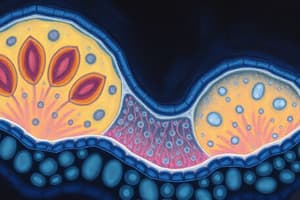Podcast
Questions and Answers
What is the initial step in the formation of nanodomains for membrane identity?
What is the initial step in the formation of nanodomains for membrane identity?
- Fusion of vesicles from the plasma membrane
- Conversion of phosphatidylinositol to P3P
- Rab-GTP binding with SNARE
- Activation of Rab by GEF (correct)
How does the identity of early endosomes change as they mature?
How does the identity of early endosomes change as they mature?
- By losing Rab 7 and acquiring Rab 5
- By maintaining a consistent PIP level
- By losing Rab 5 and acquiring Rab 7 (correct)
- By increasing the number of SNARE proteins
What role does Rab-GTP play in the process described?
What role does Rab-GTP play in the process described?
- It promotes the action of endocytosis
- It binds to motor proteins to transport vesicles (correct)
- It is a cargo selection factor
- It activates liposomes for fusion
What is the function of COPII in vesicle transport?
What is the function of COPII in vesicle transport?
Which protein complex is crucial for the fusion of vesicles with membranes?
Which protein complex is crucial for the fusion of vesicles with membranes?
What characterizes the late endosome in terms of Rab identity?
What characterizes the late endosome in terms of Rab identity?
What event initiates the cascade for the formation of microdomains?
What event initiates the cascade for the formation of microdomains?
What is an outcome of the activation of Rab 5?
What is an outcome of the activation of Rab 5?
What is the primary role of the pump found in lysosomes?
What is the primary role of the pump found in lysosomes?
Which characteristic distinguishes regulated exocytosis from constitutive exocytosis?
Which characteristic distinguishes regulated exocytosis from constitutive exocytosis?
What is a necessary condition for calcium-dependent synaptic transmission?
What is a necessary condition for calcium-dependent synaptic transmission?
In what scenario do vesicles need to fuse to increase the plasma membrane surface?
In what scenario do vesicles need to fuse to increase the plasma membrane surface?
What role do SNARE proteins play in exocytosis?
What role do SNARE proteins play in exocytosis?
What happens to calcium ions during membrane depolarization?
What happens to calcium ions during membrane depolarization?
What is a key function of the actin-myosin cytoskeleton ring during cell division?
What is a key function of the actin-myosin cytoskeleton ring during cell division?
Why is the pH of the endosome not as acidic as that of the lysosome?
Why is the pH of the endosome not as acidic as that of the lysosome?
What is the primary role of transcytosis in polarized cells?
What is the primary role of transcytosis in polarized cells?
What initiates the process of vesicle fusion when there is a membrane break?
What initiates the process of vesicle fusion when there is a membrane break?
Which of the following correctly describes the progression of early endosomes?
Which of the following correctly describes the progression of early endosomes?
What is the significance of the coat on vesicular membranes?
What is the significance of the coat on vesicular membranes?
During cellularisation, what happens to the membrane surface?
During cellularisation, what happens to the membrane surface?
What role does GDI play in relation to GTPases?
What role does GDI play in relation to GTPases?
Which of the following statements about Rab proteins is true?
Which of the following statements about Rab proteins is true?
Which protein is primarily responsible for the transport of lysosomal enzymes from the Golgi to the lysosome?
Which protein is primarily responsible for the transport of lysosomal enzymes from the Golgi to the lysosome?
What is the primary function of Ras molecules in cells?
What is the primary function of Ras molecules in cells?
What is the role of receptors in the context of membrane transport?
What is the role of receptors in the context of membrane transport?
Which protein facilitates the conversion of GDP to GTP?
Which protein facilitates the conversion of GDP to GTP?
What function does dynamin serve in the vesicle formation process?
What function does dynamin serve in the vesicle formation process?
The triskelion structure is formed by which protein?
The triskelion structure is formed by which protein?
Which GTPase is known to converge on mTORC signaling?
Which GTPase is known to converge on mTORC signaling?
What is the primary role of SNARE proteins?
What is the primary role of SNARE proteins?
Which protein interacts with the actin during the endocytosis process?
Which protein interacts with the actin during the endocytosis process?
What is the purpose of uncoating vesicles after formation?
What is the purpose of uncoating vesicles after formation?
Which of the following GTPases is not membrane-bound?
Which of the following GTPases is not membrane-bound?
What type of regulation is facilitated by coating proteins during endocytosis?
What type of regulation is facilitated by coating proteins during endocytosis?
What characterizes the interaction between vSNARE and tSNARE?
What characterizes the interaction between vSNARE and tSNARE?
How do clathrin and adaptor protein AP2 collaborate during endocytosis?
How do clathrin and adaptor protein AP2 collaborate during endocytosis?
What is the primary purpose of N-glycosylation in proteins?
What is the primary purpose of N-glycosylation in proteins?
Which modification occurs first in the process of glycosylation in the endoplasmic reticulum?
Which modification occurs first in the process of glycosylation in the endoplasmic reticulum?
What indicates that a protein is still in the earlier stages of the Golgi apparatus?
What indicates that a protein is still in the earlier stages of the Golgi apparatus?
During the glycosylation process, what happens to mannose and N-acetylglucosamine levels?
During the glycosylation process, what happens to mannose and N-acetylglucosamine levels?
What type of bond is involved in O-glycosylation?
What type of bond is involved in O-glycosylation?
What is the significance of using Endo H in experiments related to glycosylation?
What is the significance of using Endo H in experiments related to glycosylation?
What process allows proteins to be directed either to lysosomes or the plasma membrane?
What process allows proteins to be directed either to lysosomes or the plasma membrane?
Which of the following best describes a characteristic of a protein that is Endo H insensitive?
Which of the following best describes a characteristic of a protein that is Endo H insensitive?
Flashcards
Rab GTPases
Rab GTPases
GTPases involved in membrane trafficking, defining membrane identity.
SNARE proteins
SNARE proteins
Proteins that facilitate membrane fusion by bringing membranes close together.
GTP and GDP
GTP and GDP
Nucleotides involved in energy transfer and signaling, converted by GAP and GEF.
GAP and GEF
GAP and GEF
Signup and view all the flashcards
Ras superfamily
Ras superfamily
Signup and view all the flashcards
mTORC
mTORC
Signup and view all the flashcards
Rho GTPases
Rho GTPases
Signup and view all the flashcards
GDI protein
GDI protein
Signup and view all the flashcards
N-glycosylation
N-glycosylation
Signup and view all the flashcards
O-glycosylation
O-glycosylation
Signup and view all the flashcards
Mannose-6-phosphate
Mannose-6-phosphate
Signup and view all the flashcards
Post-translational modification
Post-translational modification
Signup and view all the flashcards
Endo H sensitivity
Endo H sensitivity
Signup and view all the flashcards
Sialic acid
Sialic acid
Signup and view all the flashcards
Western blot analysis
Western blot analysis
Signup and view all the flashcards
Lysosomal enzymes
Lysosomal enzymes
Signup and view all the flashcards
Lysosome acidity
Lysosome acidity
Signup and view all the flashcards
Endosome pH
Endosome pH
Signup and view all the flashcards
Regulated exocytosis
Regulated exocytosis
Signup and view all the flashcards
Synaptic transmission
Synaptic transmission
Signup and view all the flashcards
Calcium dependency
Calcium dependency
Signup and view all the flashcards
Membrane surface increase
Membrane surface increase
Signup and view all the flashcards
Phagocytosis
Phagocytosis
Signup and view all the flashcards
Transcytosis
Transcytosis
Signup and view all the flashcards
Endocytosis
Endocytosis
Signup and view all the flashcards
Exocytosis
Exocytosis
Signup and view all the flashcards
Vesicular trafficking
Vesicular trafficking
Signup and view all the flashcards
Endo-lysosomal trafficking
Endo-lysosomal trafficking
Signup and view all the flashcards
Nanodomains
Nanodomains
Signup and view all the flashcards
Rab Activation
Rab Activation
Signup and view all the flashcards
GTP
GTP
Signup and view all the flashcards
PIP
PIP
Signup and view all the flashcards
Early Endosome
Early Endosome
Signup and view all the flashcards
Rab 5 to Rab 7 Transition
Rab 5 to Rab 7 Transition
Signup and view all the flashcards
COPII
COPII
Signup and view all the flashcards
Coating Proteins
Coating Proteins
Signup and view all the flashcards
Clathrin
Clathrin
Signup and view all the flashcards
Adaptor Protein (AP2)
Adaptor Protein (AP2)
Signup and view all the flashcards
Dynamin
Dynamin
Signup and view all the flashcards
Uncoating of Vesicles
Uncoating of Vesicles
Signup and view all the flashcards
Study Notes
Vesicular Transport
- Vesicular transport moves materials between topologically similar compartments, including from the plasma membrane in and out of the cell.
- Topologically similar compartments are compatible for fusion during vesicle trafficking. Transport is regulated and directional.
- Exocytic transport: Vesicles from the endoplasmic reticulum travel to the Golgi, then to the plasma membrane for release. Release requires a continuous stimulus for vesicle fusion. Exocytosis also occurs within the cell, from the trans-Golgi network to the early/late endosome and lysosomes.
- Endocytic transport: Materials are ingested into endocytic vesicles from the plasma membrane and transported to the early endosome, then to multi-vesicular bodies, late endosome and lysosomes.
- Retrieval transport: Recycles proteins and receptors via vesicles between the plasma membrane, early endosome, lysosome, and Golgi/ER.
- Regulation: Vesicle trafficking is highly regulated; each vesicle has an identity (membrane coating) to target compartments. Phosphoinositides (PIPs), signal proteins, GTPs, and regulators of PI create nanodomains on the membrane for recognition. Vesicles move on cytoskeleton structures (microtubules). Proteins regulate and restore membrane identity during movement. Thousands of vesicles continuously move in cells.
Membrane Coating Proteins
- Membrane coating proteins (COPI and COPII). COPI moves vesicles between Golgi cisternae; COPII moves vesicles from the ER to the Golgi.
- Clathrin: Forms a triskelion structure, interacting with adaptor proteins (AP2), actin, and cargo to mediate endocytosis. Clathrin is important for clathrin dependent endocytosis and lysosome transport.
- Coating protein formation and selection: Determines which cargo is transported.
Phosphoinositides (PIPs)
- PIPs regulate membrane trafficking, modifying from PI to differing types.
- PIP3 is a major signaling lipid in plasma membranes; regulates pathways downstream of tyrosine kinase receptors.
- PI(4,5)P2 is important for endocytosis.
Vesicle Trafficking Regulators
- GTPases (Rab, Arf, Ran, Miro): Proteins that regulate vesicle trafficking and interactions; involved in membrane identity.
- Rab GTPases and SNARE proteins direct vesicles to their destinations.
- Rab proteins specify membrane identity.
Transcytosis
- Transport across cells, occurs in polarised cells with a barrier (tight junctions).
- Materials may be transported from one side of the cell to the other via endocytosis and exocytosis events.
Membrane Fusion
- Dynamin: Crucial in vesicle fission during endocytosis, and also constricts membrane resulting in vesicle budding.
- SNARE proteins (t-SNARE, v-SNARE) mediate membrane fusion.
Endosomes and Lysosomes
- Endosomes sort and direct materials.
- Mannose-6-phosphate receptors target proteins to lysosomes.
- Acidic pH of lysosomes aids in protein degradation.
Glycosylation
- N-linked glycosylation, O-linked glycosylation
- Glycosylation is critical for protein folding and targeting. Modification markers aid in protein transport.
Studying That Suits You
Use AI to generate personalized quizzes and flashcards to suit your learning preferences.





